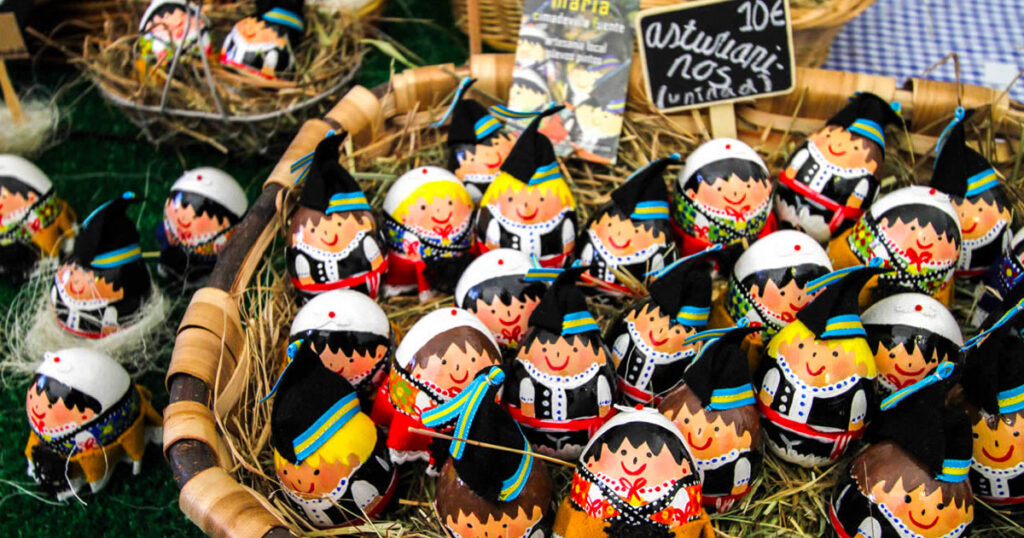
Palm Sunday behind us, Passover today, Good Friday coming up, Easter after that. A handful of special days, each with its designation, its tradition, its significance, bunched together as Holy Week, Semana Santa in Spanish. Easter might be the apex in Spain, with chocolate bunnies for children and solemn processions all over the country for the devout, the ardent, and the curious. Then the celebrations are over. Unless you live as I do in Pola de Siero and still have the fiesta of the painted eggs to look forward to, huevos pintos in Spanish and güevos pintos in Asturian. The festival is held the Tuesday after Easter. Not famous the world round, but on the lists of important cultural celebrations hereabouts and much attended. It’s a last, colorful burst of fun before the Easter celebrations are over.
This is my second Easter in La Pola, but last year I was newly arrived and still buried under a pile of boxes, unable to squirm out to partake in the festivities. When I did wriggle free, it was to appear at the town’s notary office to sign the papers for the purchase of the house that I was already living in. I remember sitting in the notary’s office across a big table from the marquesa and her family’s consigliere, who was easing both of us through the process. I was surprised that she seemed nervous—half the town had belonged to her family once, my little house being just a crumb of the cake the family had feasted on for ages. The notary appeared, confirmed our identities, gave us the document of sale, and then disappeared, allowing us time to read what we would shortly sign.
As soon as he was out of the room, the agent commented that the notary’s absenting himself from the room was routine: it was an old habit of notaries to protect themselves from implication in any irregularities in the deal, such as partial payment under the table to save on taxes. The marquesa and I listened. Then the notary reappeared to read the document aloud, ask if we had any questions, verify the payment (which was the receipt for a bank transfer I had already made), explain that we’d get a copy eventually of the papers, and remind me of the costs still to be assessed—the taxes, the registration costs, and the notary fees, together amounting to about 10 percent of the sale price. And that was it. I owned a house, all my own, my first ever. I wanted to get back to it. I wasn’t even conscious of the town’s festivities.
This year is different. My world has expanded beyond the walls of my house. I will go down to the town’s main park in the late morning, wander through the line of stalls where artisans and merchants display their goods, principally the painted eggs. No reader of this post needs reminding what colored, dyed, or painted eggs are. But until you’ve seen dozens of them beautifully painted in scenes of astonishing detail, you can’t imagine the intricate care and great talent used to create such fragile artifacts. The tradition of painted eggs stems, I read, from the accumulation of eggs during Lent, when no meat or dairy was consumed. Afterward, one could both celebrate and eat, and so it was.
I first visited the painted eggs celebration about 10 years ago. A collection of beautifully decorated eggs I could imagine, but hundreds to admire? Originally the eggs were cooked in the old kitchens and colored with soot from the fire, and the first color they had was simply dark. Or they were boiled with chestnuts and acquired a reddish tone. Later, new dyes and tools came into use. India ink was used, paints and washes. Brushes and calligraphy pens replaced twigs dipped in wax. The eggs were decorated with traditional scenes on one side, often with pithy counsel on the other. Nowadays you can see tiny renditions of Las Meninas or Guernica, or characters from children’s cartoons.
I expect to see people thronging the market when I go. I will view all kinds of baked and fried pastries, many savory dishes, cider opened and poured, bars with tables set out serving wine, beer, and plates of one specialty or another. The day is a holiday in La Pola. Children will still be on their Easter break. I will watch the people, who will come and go all afternoon and into the evening, and I will join them for a while. Later, back at home, I will hear the happy sounds of the verbena, the big outdoor party with food and music, dance and drink, that will not conclude until the day, like so many good days, runs over into the next. And so life goes on, one day running into the next, one year into the following, one decade merging with another. Sometimes we stand midpoint, looking ahead and back. This year, last, next. With luck, something unexpected, a reprieve, joyous and bright, around the bend, before it’s all over.

